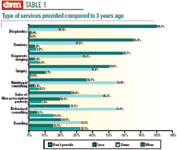Advanced Study
National Report - Veterinary medicine is more specialized today than it was just a few years ago. Not only are general practitioners offering significantly more diagnostic, dentistry, imaging and surgery services in-house, they say they are referring more patients to specialists, too.
NATIONAL REPORT — Veterinary medicine is more specialized today than it was just a few years ago. Not only are general practitioners offering significantly more diagnostic, dentistry, imaging and surgery services in-house, they say they are referring more patients to specialists, too.
More than 80 percent of practitioners report offering more diagnostic services than three years ago, according to respondents to the DVM Newsmagazine 2006 State of the Profession Survey. More than 65 percent of respondents say they offer more dentistry services; almost 59 percent offer more imaging, and more than 50 percent perform more in-house surgeries.

Table 1 Type of services provided compared to 3 years ago
About one-third offer more nutritional consulting, and about one-quarter have boosted behavioral consulting and non-prescription product sales.
But the heightened expertise doesn't appear to be putting a dent into outside referrals. Almost one-third of respondents report referring five or more cases in an average month, and 57 percent say they are referring more cases.
"We've seen a relatively uniform growth over the last several years; we, as well as many of the specialty practices that I know, are seeing 10 percent to 20 percent growth (in revenue)," says Darryl Shaw, practice manager of Florida Veterinary Specialists in Tampa. "In terms of new clients, we're seeing maybe 5- to 15-percent growth."
Shaw credits some of the progress to a growing practice that benefits from increasingly more specialists in the marketplace due to "the expanding array of internships in private practice."
Last year, about 31 percent of women and 27 percent of men graduating from veterinary schools pursued advanced study, according to an American Veterinary Medical Association survey. In 2001, less than 24 percent of women and 22.4 percent of men pursued advanced study after veterinary school.

Table 2 Types of cases typically referred to specialists
A growing, more specialized veterinary workforce translates into a burgeoning market for referral centers. In July, the Massachusetts Veterinary Referral Hospital, boasting 26,000 square feet, reported it plans to increase its staff 15 percent to 20 percent during the next three years to accommodate its eventual 44,000-square-foot plan.
Dove Lewis' 23,000 square feet, which also opened in July, represents the fourth large referral center in Portland, Ore. But there is plenty of business to go around, says Dr. Robert Mack, Dipl. ACVIM, a principal with Northwest Veterinary Specialists, which has served the Portland area for about seven years.
"Competition is certainly growing because 15 years ago, the vast majority of specialists were in academia, and there has been a tremendous boom in the number of specialty practices that have arisen in the last 10 years," Mack says. "In Portland alone, we have seen it go from two internists in the city when I first was here to six or seven and 10 to 12 board certified surgeons, but all of them are staying relatively busy, so even though there is more competition, as the city grows and awareness grows, I don't think any one has suffered from it. But I do suppose that there will be some sort of ceiling where specialists continue to become a higher and higher percent of the total number of veterinarians, then that might affect things, but we haven't seen that yet."
Northwest Veterinary Specialists generated about $1 million in its first year. It expects to exceed $8 million this year. The practice is in the final planning stages for an 8,000-square-foot addition to its medical facilities, which will span 18,000 total square feet, plus 3,000 square feet for its management team.
"The referral practice is pretty accepted here in the Northwest," Mack says.
The heightened acceptance from general practitioners around the country and the public's growing awareness and interest in specialized veterinary medicine has fueled growth as well.

Table 3 Number of outside referrals compared to three years ago
"The public increasingly desires to provide the same level of care for their pets that they do for themselves or for their family," Shaw says. "In line, you are seeing general practitioners becoming more sophisticated and appreciative of what can be offered, and new veterinarians graduating from school are more comfortable with referring."
Ophthalmology and orthopedics were the most commonly cited referral cases, according to the DVM Newsmagazine survey; about three-fourths of respondents say they refer these cases. About half or respondent refer oncology, neurology and ultrasound or diagnostic cases, and about one-third refer cardiology, internal medicine, dermatology and surgery cases.
But just as more first-generation referral centers come online, succession plans remain in unchartered territory.
"In 10 to 20 years, all the people who started these practices are going to be looking for a way to exit and get back a return for all their hard work and effort," Mack says. "One way is that you are going to have your associates or other doctors buy-in, and those people will have to be convinced that the investment into the hospital will be better than an investment in the stock market or land, for example. Or you must rely on corporate America to buy your practice. But VCA is not going to buy every single practice, and not everyone wants to sell to VCA, so I don't know what the future will hold."